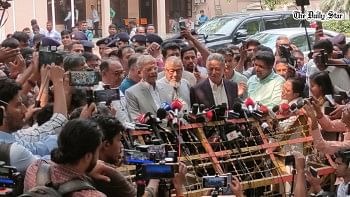RMG exporters bracing for difficult times as orders slow

Apparel exporters are anticipating that the next six months will be challenging for the garment industry in Bangladesh as they receive fewer work orders from international buyers amid inflationary pains and depressed customer sentiments.
They are, however, hopeful about a rebound from December as the impact of a hike in bank interest rate in Bangladesh would ease and consumer prices would maintain their downward trend in the western countries.
"I don't see any possibility of a brighter prospect for garment exports in the next six months because the economies in the European Union and the US are yet to start performing strongly," said Md Fazlul Hoque, managing director of Plummy Fashions Ltd, a Narayanganj-based knitwear manufacturer.
The EU and the US, the main export destinations for Bangladesh, account for about 85 per cent of the country's apparel shipment.
One encouraging sign is consumer prices, which surged to a multi-decade high last year owing to the escalation of energy prices fuelled by the Russia-Ukraine war, are on the decline in the key markets.
In the US, for instance, inflation was 4.9 per cent in the 12 months to April, the first time it fell
below 5 per cent in two years, way lower than the four-decade high of 9.1 per cent seen in June last year.
Similarly, the eurozone's annual inflation rate fell by more than expected in June to 5.5 per cent amid sharp falls in the cost of energy, down from a 40-year-high of 10.7 per cent recorded in October.
But local suppliers are worried as their cost of funds might go up after the Bangladesh Bank moved away from the 9 per cent lending rate cap, which had been in place from April 2020 to June this year.
According to Hoque, they came to know about the direction of exports based on queries from international retailers and brands.
"The number of queries from buyers for the next season is low because of the fallout of the war and the overall economic trend in the EU and the US."
He and a number of exporters sounded out pessimism despite the overall shipment from Bangladesh hitting a record high of $55.55 billion in the just-concluded fiscal year and the receipts from the garment sector managed to register a year-on-year growth of 10.27 per cent to $46.99 billion.
Industry people say the growth in times of global economic slowdown took place mainly in terms of value, not in terms of volume, as international retailers and brands paid better prices after taking into account the hike in the raw material costs and the spike in the cost of production in Bangladesh.
"How can the export of garment items be better when European and US consumers are passing through an economic downturn?" asked Md Siddiqur Rahman, chairman of Sterling Group, a garment exporter.
"The export growth in FY23 was not a growth in a real sense as buyers adjusted the prices."
MA Jabbar, managing director of DBL Group, a garment exporter, thinks the export would be better from December as the economic situation may be better in the western world.
"The growth will be low in the next two months."
The current work order situation for garment items is not encouraging as buyers are cautious, said another garment exporter, asking not to be named.
"I do not see any jump in work orders in the next six months and everything is depending on the war situation."
Faruque Hassan, president of the Bangladesh Garment Manufacturers and Exporters Association, said the shipment to new markets, particularly in Asian nations such as Japan, South Korea and India, increased in FY23 and buyers also paid better prices.
He said the global market for garment items currently worth nearly $750 billion may shrink by 20 per cent this year because of lower consumption by western consumers.
Earlier, global management consulting firm McKinsey & Company said hyperinflation and depressed customer sentiments resulted in declining growth rates in the global fashion industry in the second half of 2022.
"We expect that the slowdown is likely to continue through 2023."
Mohammad Ali Khokon, president of the Bangladesh Textile Mills Association, thinks the depreciation of the local currency against the US dollar by nearly 28 per cent in the past one year has made Bangladesh's exports more competitive.
"But importers had to pay more for the US dollar to import raw materials."
Buyers are not optimistic because of the ongoing economic slowdown, said Mohammad Hatem, executive president of the Bangladesh Knitwear Manufacturers and Exporters Association.
However, MA Razzaque, research director of the Policy Research Institute of Bangladesh, gave a mixed outlook on garment export for the new fiscal year, which began on July 1.
Apparel shipment to the US declined for all countries, including Bangladesh, in the February-May period of 2023.
"So, it will depend on how quickly the US and the EU could tackle their downward trend in the economies," he said.
According to the researcher, Bangladesh is competitive in the global apparel market whereas China is losing its market share. "So, Bangladesh has a very good future."
China, the largest apparel supplier in the world, is losing its market share for three reasons: diversification of sourcing by western retailers and brands as they see China as a sensitive source; China's shift to more sophisticated items like capital machinery, solar panels, electrical vehicles and mobile gadgets; and higher cost of production.
The geo-political tensions such as the dragging tariff war between Washington and Beijing is also contributing to the lowering of garment exports from China, Razzaque added.

 For all latest news, follow The Daily Star's Google News channel.
For all latest news, follow The Daily Star's Google News channel. 



Comments